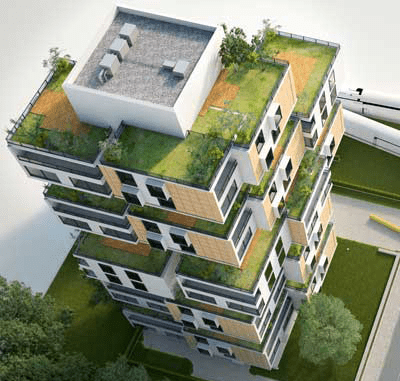Amuktamalyada Pothamsetty
Terra Viridis Consultants LLP, Hyderabad, India
Corresponding Author: ar.amuktamalyada@gmail.com
Faiz Ahmed Chundeli
School of Planning and Architecture, Vijayawada,
Cite this article
Highlights
- Delineates a methodology to study urban residential neighborhoods to understand the effect of urban morphology on microclimate.
- Enumerates morphology parameters that can be modified to reduce the UHI phenomenon.
- A numerical model, ENVI-met, simulates microclimate and various statistical models to evaluate the extent of the inter-relationship between critical morphology parameters and climate variables.
Abstract
Urbanization, changing urban geometries and surfaces, forms hotspots called urban heat islands (UHI). Several studies have been conducted to understand its cause, intensity, and impact on urban microclimate. The current study attempts to assess the impact of the urban morphology of multiple residential urban blocks in Hyderabad on urban heat island intensity. The study explores the possibility of UHI mitigation by modifying morphology constructed on policy measures like zoning regulations. Six urban residential blocks under the city’s peri-urban belt are studied for their morphology and microclimate. Field study, 2D building database, and satellite imagery are used to develop urban built geometry of the blocks. The microclimate, i.e., air temperature and wind speed, is determined using a numerical model, ENVI-met. The simulated microclimate data is used to compute UHI intensity based on reference climate data of an urban block at the time of the investigation. The urban morphology is then modified to reduce UHI intensity. The modified urban geometry with a significant reduction in UHI intensity is used to suggest planning/design recommendations through zoning regulations. Further, the paper reinforces the significance of the correlation between UHI and urban morphology, which can be regulated through zoning.
Keywords
Microclimate, Urban Heat Island, Urban Morphology, UHI Mitigation, Zoning Regulations
References
- V. Oliveira, The elements of urban form. In V. Oliveira, Urban morphology: An introduction to the study of the physical form of cities, Switzerland: Springer, 2016.
- S. Tsoka, K. Tsikaloudaki, T. Theodosiou and D. Bikas, “Urban warming and cities’ microclimates: Investigation methods and mitigation strategies- A review,” Energies, vol. 13, no. 6, 2020. https://doi.org/10.3390/en13061414
- T. R. Oke, “The energetic basis of the urban heat island,” Q. J. R. Meteorol. Soc., vol. 108, pp. 1-24, 1982. https://doi.org/10.1002/qj.49710845502
- Y. Park and G. O. Rogers, “Neighborhood planning theory, guidelines, and research: Can area, population, and boundary guide conceptual framing?,” J. Plan. Lit., vol. 30, no. 1, 2014. https://doi.org/10.1177/0885412214549422
- V. K., P. K.M. and V. T.N., “Urban heat island studies: Current status in India and a comparison with the International studies,” J. Earth Syst. Sci., vol. 129, 2020. https://doi.org/10.1007/s12040-020-1351-y
- M. Kamraju, “Urban Sprawl and Sustainable Development in Hyderabad: A Geoinformatic Approach,” International Journal of Creative Research Thoughts, 2018.
- M. P. Heris, A. Middel and B. Muller, “Impacts of form and design policies on urban microclimate: Assessment of zoning and design guideline choices in urban redevelopment projects,” Landsc. Urban Plan., vol. 202, 2020.
- R. Kotharkar, A. Bagade and A. Ramesh, “Assessing urban drivers of canopy layer urban heat island: A numerical modeling approach,” Landsc. Urban Plan., vol. 190, 2019. https://doi.org/10.1016/j.landurbplan.2020.103870
- S. Sultana and A. Satyanarayana, “Urban heat island intensity during winter over metropolitan cities of India using remote-sensing techniques: impact of urbanization,” Int. J. Remote Sens., vol. 39, no. 20, pp. 6692-6730, 2018. https://doi.org/10.1080/01431161.2018.1466072

 Bishal Thapa
Bishal Thapa





 Fred Sherman
Fred Sherman Sumedha Malaviya
Sumedha Malaviya Satish Kumar
Satish Kumar












 The three main global energy concerns of providing access to modern energy, enhancing the security of the energy supply, and minimising the impact of energy systems on the climate have an impact on both national and international energy governance. To develop solutions that address the many facets of these difficulties, however, a variety of actors and stakeholders must be included due to the complexity of the energy challenges.
The three main global energy concerns of providing access to modern energy, enhancing the security of the energy supply, and minimising the impact of energy systems on the climate have an impact on both national and international energy governance. To develop solutions that address the many facets of these difficulties, however, a variety of actors and stakeholders must be included due to the complexity of the energy challenges. Cities are responsible for more than 70% of the world’s energy consumption and 40% to 50% of its greenhouse gas emissions. Managing increasing urbanisation is a challenge, and nations must deal with the effects it will have on the environment in terms of energy and climate.
Cities are responsible for more than 70% of the world’s energy consumption and 40% to 50% of its greenhouse gas emissions. Managing increasing urbanisation is a challenge, and nations must deal with the effects it will have on the environment in terms of energy and climate. Our transition to a future with lower carbon emissions depends heavily on buildings. They are our places of residence, rest, and employment; they also account for around one-third of the world’s greenhouse gas emissions and nearly 40% of the world’s energy usage.
Our transition to a future with lower carbon emissions depends heavily on buildings. They are our places of residence, rest, and employment; they also account for around one-third of the world’s greenhouse gas emissions and nearly 40% of the world’s energy usage.